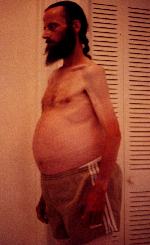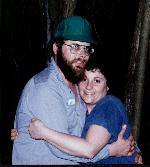GABE HOZ: Courage
Gabe Hoz was a young man who died of mesothelioma at the age of 40. He was diagnosed with abdominal mesothelioma in November, 1995. He consulted with several hospitals in New Jersey and New York, all of which recommended surgery. Gabe and his wife Teresa decided they would pursue alternative remedies at a clinic in the Bahamas. After eight weeks of treatment, he returned home to New Jersey, where Tre Smith, my co-counsel in New York, took his deposition.
Although this account of the last few days of Gabe's life may be considered morbid, I believe it must be told. We can't hide the awful truth of the all too real human consequences of the asbestos companies' outrageous misconduct. The massive tumor in his stomach had left Gabe extremely weak. He was confined to a chair that tilted back and forth, which relieved the pressure of the swelling of his legs. He had one timer that went off every hour or so to remind him to inject himself with the immune augmentation serum. Another timer reminded him to take his morphine. To inject himself, Gabe would pick up the needle with his good left hand (the disease had left his right hand almost useless) and pump it into the left bicep. His arms were so emaciated -- his forearm was twice as wide as his upper arm. When he injected himself, he took on the aspect of a praying mantis.
Two days before his deposition, Gabe fell and was rushed to the hospital. The doctors didn't know if he had passed out from an overdose, so they pump him full of anti-narcotics, which caused him to shriek in agony from the pain. When Tre got to the hospital they were still having a hard time getting his blood sugar up. Tre encouraged him to eat some pineapple, which he forced down like he was swallowing cactus. Gabe told Tre that while "unconscious" after his fall, he'd floated over his fallen body and reminded himself to quickly get back into his body and get ready for his deposition.
On the day of his trial testimony, his throat was so dry and inflamed that he could not swallow his pain pills. At the deposition, Gabe had to use a microphone. The disease affected his hearing somehow, and he was so weak that it was an effort for him to speak loudly. Tre told Gabe that he looked like the Great Humongous [a character in "Road Warrior"]. He got the reference, and cracked a smile. This is how engaging a person Gabe was. There was a lawyer named Tim something or another, who was closest to the amp that the mike was wired into. The volume control was on it. Whenever there was a break in the testimony, Gabe would say, "Tim, would you cut the mike . . . Thank you, my man!" Each of the lawyers who questioned Gabe would begin by introducing themselves, and Gabe each time replied by saying, "Hi (first name of______)." Here is this dying man and he bothers to establish a rapport with his Tormentors, to treat them with dignity and humanity.
At times as he was testifying his eyes would literally roll back in his head. He would stop to think, and his drugs would kick in and numb his brain out. It looked like a petitmal epileptic seizure. When we did the video, Tre lent him his white button down (Tre is a 6'2", 210 pound weight lifter). The shirt dwarfed his baby shoulders, but he couldn't button the bottom three buttons on the shirt because of the massive tumor in his belly.

Gabe testified that his concern was not for himself, but for his wife and mother. He was worried about who was going to take care of them. Gabe said that when he got his diagnosis, he went to his computer and at 2 o'clock in the morning, after having read 20 or so medical articles on mesothelioma, and each time seeing the words "untreatable", there, alone, he began to weep, and he wept when he remembered this moment in front of the camera.
Tre's account speaks for itself: "But the most wrenching moment was when I asked him to stand up and take his shirt off. I helped him to stand by putting my hands under his armpits, and then positioning the crutches underneath for support, then working around the crutches and getting the shirt off. The back of his shirt was so drenched with sweat that it was discolored by the fabric of the chair. He was finally standing there, alone, the camera was turned back on, and this intelligent, gentle, former bear of a man realized that he was now the Elephant Man, grossly disfigured from the tumors. As he stood there, I think his shoulders actually shook a little, as he wept. I asked him to turn around, and he shuffled his feet in a slow dance-like circle and turned his back to us, for the ultimate horror: the sight of his spinal column, rising like the spine of a sea horse from the middle of his back straight up to his neck. His skin looked like cellophane shrink wrapped onto his bones."
Gabe Hoz died two days later. Teresa's wrongful death case is set for trial in November, 1996 in New York City. What sickens me is that if a young man contracts AIDS, there are federally funded treatment programs available. But for mesothelioma victims, there is nothing. One can make a strong argument that many AIDS victims were aware of the risks of unprotected sex and sharing hypodermic needles back in the early 1980s, when the disease was first reported in the newspapers. On the other hand, nobody can claim with a straight face that twenty million American workers knew and appreciated that inhaling asbestos fibers could cause mesothelioma 20-40 years later. Yet, all the public attention and government money goes to bail out the AIDS victims, leaving the asbestotics to fend for themselves.
Gabe and Teresa were drained of their life savings battling against a horrible tumor that was the direct result of his being poisoned by the asbestos companies. Did the asbestos companies offer to pick up his medical bills? No. Instead they grilled him for two days and he died 48 hours later.


